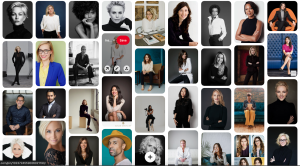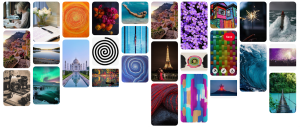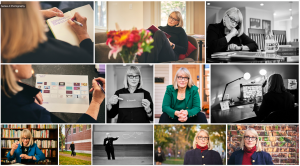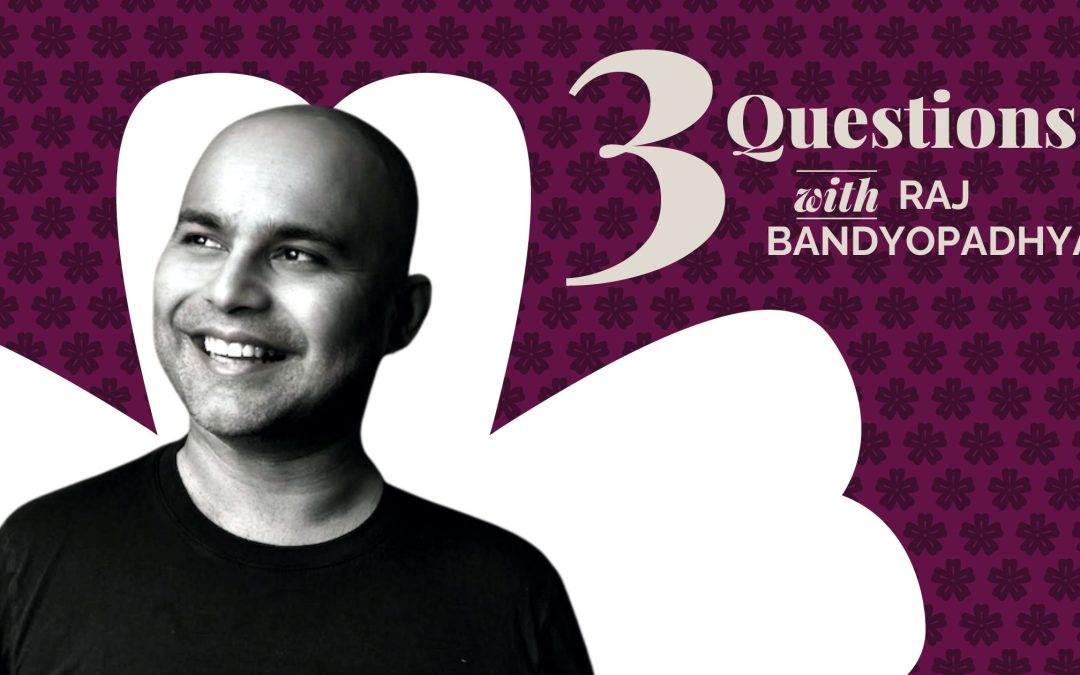This month we asked Raj Bandyopadhyay, Owner of Series A Photography, about how to build your personal brand.
Q: What exactly is a personal brand?

Client photo: Margaret Andrews, on Harvard University campus.
A: The concept of “Personal Brand” is everywhere nowadays, and evokes a variety of strong emotions. Some people recoil from the very idea of branding, believing it to be ‘fake’, while others embrace it whole-heartedly, seeing it as an additional dimension of their work. But before we get into how to build a personal brand, let’s talk about what it actually is. Here are a couple of definitions from sources you might know.
“Your personal brand is what people say about you when you’re not in the room” – Jeff Bezos, Founder of Amazon.com
“Personal branding is an intentional, strategic practice in which you define and express your own value proposition” – Harvard Business Review, May 2023
Both of these definitions capture aspects of personal branding, but they’re incomplete. In my work as a professional photographer, I think of a personal brand as the relationship that you have with your ideal audience. I work with each of my clients to identify their exact audience, and what that audience would respond viscerally to when they see my client’s photos.
That begs the question, WHO is your ideal audience?
As an academic, and academic leader, you have more audiences to address than most business professionals – faculty, staff, current students, potential future students, alumni, donors, research funders, the campus community, the off-campus community, recruiters, and the media, among others. These are all groups that need to understand who you are, what you stand for, and what you can do to help them.
But why do I need to care about all of this? Shouldn’t my work speak for itself?
In an ideal world, YES! But in reality, we are all human, and we bring our human biases and tendencies with us. People are more likely to listen to someone they trust, and trust is built over time, through a combination of establishing credibility, consistently delivering value, and demonstrating human elements of empathy and connection.
In simpler terms, when you show someone that you understand their view of the world, you care about them, and you have the knowledge and skill to do so, they’re more likely to trust you. That is what your personal brand needs to convey in your own unique voice.
Exercise: Identify one key audience you want your brand to build a relationship with. What problem are you helping them with? Why do you care about this particular audience? What authority/credentials/knowledge do you have that can help them?
Q: What should I share in my personal brand?
A: You already know how to communicate your work in professional settings: research proposals, papers, conferences, student conversations, faculty meetings. While the content of your communication might remain the same, your language and style has to adapt to your audience.
But your personal brand is not just about the content of your work. You also have to convey the other thing that makes your work unique and interesting – YOU.

Your brand is an opportunity to convey not just your knowledge, but also your personality and style. Client photo: Kat O’Sullivan
Here’s a question I want you to pause and think about. Why does my audience come to ME rather than anyone else in my field working on similar topics?
What is your essence? It might be your personality that lights up a classroom, your teaching philosophy and style, or even your personal story of what brings you to work every day. How can you infuse those intangible elements more into your brand, when you’re talking about your work?
At this point, I sometimes hear concerns from my clients about oversharing. I don’t want to make it all ME ME ME! What if I share something inappropriate in a professional setting?
Those are all valid concerns, and there’s no single right answer. However, I’ll share three principles that will help you decide how much to share in different settings.
- You’re in control of your brand. You get to decide what you share, how much you share, and how you frame it for your audience.
- Your audience wants to hear what you have to say, and they have chosen to hear it from YOU. You probably can share a little more of yourself than you think.
- When you share from a genuine place of service and desire to help your audience, rather than from a place of ego, they will be more receptive to your message.
Once you have a few ideas for what to say in your brand, you have to express those ideas, values and messages in different ways. Your academic CV, website, conference talks, publications, books, social media, TV interviews, podcasts, YouTube, all of these and others are channels at your disposal. They require you to express your brand in a combination of images, writing, audio, video and other media formats, many of which are visual.
Exercise: What’s your secret (and not-so-secret) sauce? Why does your audience come to YOU as an expert, rather than anyone else in your field who does similar work? Don’t just focus on your degrees, credentials or official titles, but think of the intangibles: your personality, style, values, teaching philosophy etc.
Q: How do I figure out what my brand visually looks and feels like?
A: Visuals convey information and emotion.
Academic communication has its own share of visuals. A chart communicates a trend much more concisely than a whole page of words. A diagram can simplify a complex idea. A table makes it easy to compare and contrast elements. A great visual can often take a life of its own, becoming a chunk of information that’s widely shared and appreciated.
But, have you wondered why academic papers have such rigorously standardized formats? Besides convenience and consistency, academia aims to reduce the emotional elements of discourse. Academic research is meant to be rigorous, dispassionate, rational, following the scientific method and free from emotional manipulation. That approach is necessary for advancing knowledge in a systematic manner in a research-driven community, but it also means that academics often fail to appreciate the value of emotion in communication.
The visual elements of your personal brand can fill that emotional gap. You may have created an academic CV, a research website, or even a social media account. Within that, you have to make choices about colors, fonts, photos, illustrations, videos, layout, design and other visual elements. These choices communicate your personality, style, approach and your values, subconsciously and without words.
How can you distill your entire self into these visual elements?
There are many ways that branding and design professionals approach this. You might answer a brand questionnaire, or write in your journal. One tool that I love using with my clients is called a mood board, a collection of images that help you explore and express your values visually, capturing some elements of your brand that you might have a subconscious preference about but may not know how to quite articulate.
Here are a few sections from my client Margaret’s mood board.



When I went through Margaret’s mood board with her, here are some words that emerged: sophisticated, professional, thoughtful, trustworthy, warm, provocative, authoritative.
What do you see in there?
Exercise: Spend 30 minutes browsing the internet collecting images that resonate with you and put them in one place: a Pinterest board, a physical board, Google slides or even a folder. Review them and notice if there are any interesting or unexpected patterns. Can you summarize your board in 3-5 descriptive words or phrases?
Q: How does photography fit into my brand?
A: You have many choices as to how you want to convey your personal brand: writing, audio, video, illustrations, and of course photos. Which one do you choose?
I recommend a strategy that incorporates all of these media intentionally, considering their pros and cons.
Writing, video and audio formats give you the room to go deep into your ideas and explain them clearly to those who want to engage with them. However, watching a video, reading a blog post, or listening to a podcast – all of these take time and demand attention, both of which are in short supply nowadays.
In contrast, consider the humble photograph. The human brain processes visuals 60,000 times faster than text. A photo takes milliseconds for us to process. It bypasses our thinking, critical brain to take a message directly to our subconscious. That is exactly why to this day, every big and small brand still invests heavily in creating eye-catching photographs. No matter how you choose to express your brand, images will play a critical role.
I have a great headshot. Why do I need anything more?
A single photo of you, even a great one, can only show a small slice of who you are. A headshot is meant to be used for a limited purpose: your LinkedIn profile, book jacket, speaker bio.
The true power of photos emerges when you use a variety of them to convey different messages over time. Just like in any relationship, your audience needs to see different aspects of who you are. Photos are a quick, effective way to share these different ideas and emotions.

Having photos in many different sides of yourself helps convey a full picture of your brand. Client: Margaret Andrews, Harvard University
Your brand also requires photos in multiple contexts: social media posts, blog posts, event flyers, speaker and author media kits. When you have a variety of photos with different outfits, poses, widths (horizontal or vertical) you can use those photos to further enhance your communications, such as a blog post, podcast thumbnail, etc. Besides, wouldn’t it be more fun to have different options?
Exercise: Do a quick Google Image Search of yourself i.e. search for yourself on Google and click “Images” at the top. What are the pictures that come up in the first few rows? Do you feel like they convey your brand in an accurate and holistic manner?
Q: Can professional photos actually look like ME?
- I’m so uncomfortable on camera
- I don’t like wearing makeup
- I don’t know how to pose
- I don’t have a “model” body
- I’ve never had a photo that looks like ME
If you resonated with any of those statements, you’re not alone. Every client I’ve worked with has shared one of these fears (or others) with me in their first call.
You may have been to a photo shoot experience in the past that went like this: you show up with some pretty outfits (that you don’t normally wear), put on a ton of makeup (even if you normally don’t), get into some awkward poses (that your body doesn’t normally get into) and plaster a smile on your face for the camera (even if it’s not how you smile or show up).
If everything you’re expected to do in a photo shoot is something that doesn’t align with who you are in your life, of course your photos are not going to look like you!

Your brand photos are not about contorting into “standard” poses, but about expressing your own unique essence naturally through your body and face. Client photo: Patricia Blassie
What if we could reframe the experience of photography? You might be used to thinking of “good photos” as a set of standards you have to contort yourself to fit into. Instead, what if you saw photos as a way to express your inner essence, with your unique body, face and style?
When my clients start thinking about photography in that new frame, the concerns about specific poses and makeup often recede into the background. Instead of worrying about replicating a specific “standard” pose, we consider what they want to express and what they want to make their audience feel in each photo.
And then together, we figure out how they express that emotion through their own body and face, while I help tweak it to look fabulous on camera.
Exercise: Take a quick selfie. Now close your eyes, take a few deep breaths, and go back to a moment where you felt confident and proud of yourself. Visualize everything about that moment. Exhale, open your eyes and take another selfie. Notice the difference.
—
Wondering how photography can play a role in your brand? You can check out Raj’s website and download his free Guide to Intentional Marketing, an in-depth case study of how one of his clients thoughtfully uses her photos in her brand.
Visit www.wibenetwork.com for more information on Women in BizEd.

